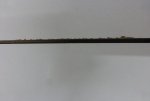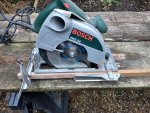Graham376
Well-Known Member
I wouldn't get too hung up on power, anything above 1000 W will be adequate, what is important is a good blade and feed rate just the same as with a file or a handsaw let the tool do the work don't try to force or pressurise it.
As you say, blade (tooth count) is more important than just power and most circular saws come with general purpose blades which are a compromise for all jobs. Some of the cheaper saws have odd sized blades so alternatives for clean cross cutting or ripping may not be available.





